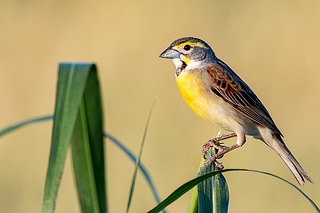
Cardinalidae is a family of New World-endemic passerine birds that consists of cardinals, grosbeaks, and buntings. It also includes several other genera such as the tanager-like Piranga and the warbler-like Granatellus. Membership of this family is not easily defined by a single or even a set of physical characteristics, but instead by molecular work. Among songbirds, they range from average-sized to relatively large, and have stout features, some species with large, heavy bills.

The South Saskatchewan River is a major river in the Canadian provinces of Alberta and Saskatchewan. The river begins at the confluence of the Bow and Oldman Rivers in southern Alberta and ends at the Saskatchewan River Forks in central Saskatchewan. The Saskatchewan River Forks is the confluence of the South and North Saskatchewan Rivers and is the beginning of the Saskatchewan River.

The lark sparrow is a fairly large New World sparrow. It is the only member of the genus Chondestes.
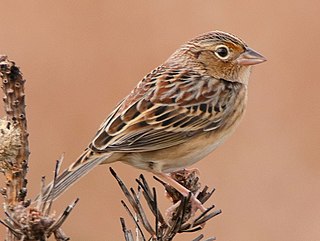
The grasshopper sparrow is a small New World sparrow. It belongs to the genus Ammodramus, which contains three species that inhabit grasslands and prairies. Grasshopper sparrows are sometimes found in crop fields and they will readily colonize reclaimed grassland. In the core of their range, grasshopper sparrows are dependent upon large areas of grassland where they avoid trees and shrubs. They seek out heterogenous patches of prairie that contain clumps of dead grass or other vegetation where they conceal their nest, and also contain barer ground where they forage for insects, spiders, and seeds. Grasshopper sparrows are unusual among New World sparrows in that they sing two distinct song types, the prevalence of which varies with the nesting cycle. The primary male song, a high trill preceded by a stereotyped series of short chips, is reminiscent of the sounds of grasshoppers and is the origin of this species' name. Like some other birds of the central North American grasslands, this species also moves around a lot, not only via annual migrations, but individuals frequently disperse between breeding attempts or breeding seasons. Grasshopper sparrows are in steep decline across their range, even in the core of the breeding distribution in the tallgrass prairies of the central Great Plains. The Florida grasshopper sparrow is highly endangered.

Henslow's sparrow is a passerine bird in the family Passerellidae. It was named by John James Audubon in honor of John Stevens Henslow. It was originally classified in the genus Emberiza and called Henslow's bunting.

The sedge wren is a small and secretive passerine bird in the family Troglodytidae. It is widely distributed in North America. It is often found in wet grasslands and meadows where it nests in the tall grasses and sedges and feeds on insects. The sedge wren was formerly considered as conspecific with the non-migratory grass wren of central and South America.

The Canada warbler is a small boreal songbird of the New World warbler family (Parulidae). It summers in Canada and northeastern United States and winters in northern South America.

LeConte's sparrow, also known as LeConte's bunting, is one of the smallest New World sparrow species in North America.

The sharp-tailed grouse, also known as the sharptail or fire grouse, is a medium-sized prairie grouse. One of three species in the genus Tympanuchus, the sharp-tailed grouse is found throughout Alaska, much of Northern and Western Canada, and parts of the Western and Midwestern United States. The sharp-tailed grouse is the provincial bird of the Canadian province of Saskatchewan.
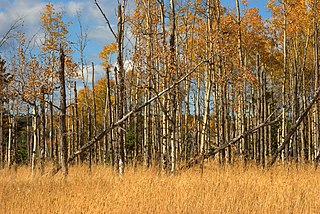
Aspen parkland refers to a very large area of transitional biome between prairie and boreal forest in two sections, namely the Peace River Country of northwestern Alberta crossing the border into British Columbia, and a much larger area stretching from central Alberta, all across central Saskatchewan to south central Manitoba and continuing into small parts of the US states of Minnesota and North Dakota. Aspen parkland consists of groves of aspen, poplar and spruce, interspersed with areas of prairie grasslands, also intersected by large stream and river valleys lined with aspen-spruce forests and dense shrubbery. This is the largest boreal-grassland transition zone in the world and is a zone of constant competition and tension as prairie and woodlands struggle to overtake each other within the parkland.

Harris's sparrow is a large sparrow. Their breeding habitat is the north part of central Canada, making it Canada's only endemic breeding bird. In the winter they migrate to the Great Plains states of the United States, from southern South Dakota to central Texas. The common name of this species commemorates the American amateur ornithologist Edward Harris (1799–1863).

Botteri's sparrow is a medium-sized sparrow.

Cassin's sparrow is a medium-sized sparrow.

Sprague's pipit is a small songbird (passerine) in the family Motacillidae that breeds in the short- and mixed-grass prairies of North America. Migratory, it spends the winters in the southwestern United States and northern Mexico. Sprague's pipits are unusual among songbirds in that they sing high in the sky, somewhat like a goldfinch or skylark. It is more often identified by its distinctive descending song heard from above than by being seen on the ground. Males and females are cryptically coloured and similar in appearance; they are a buffy brown with darker streaking, slender bills and pinkish to yellow legs. Sprague's pipit summer habitat is primarily native grasslands in the north central prairies of the United States and Canada. The species was named after the botanical illustrator Isaac Sprague.

Bachman's sparrow, also known as the pinewoods sparrow or oakwoods sparrow, is a small American sparrow that is endemic to the southeastern United States. This species was named in honor of Reverend John Bachman.

New World sparrows are a group of mainly New World passerine birds, forming the family Passerellidae. They are seed-eating birds with conical bills, brown or gray in color, and many species have distinctive head patterns.
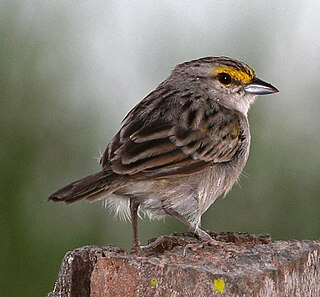
The yellow-browed sparrow is a species of bird in the family Passerellidae. First described by Johann Baptist von Spix in 1825, this American sparrow is found across much of the Amazon basin in South America. Its natural habitats are subtropical or tropical moist shrubland, pastureland, and heavily degraded former forest.
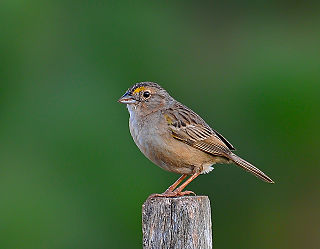
The grassland sparrow is a species of bird in the family Passerellidae. It is found in Argentina, Bolivia, Brazil, Colombia, French Guiana, Guyana, Paraguay, Peru, Suriname, Uruguay, and Venezuela. Its natural habitats are dry savannah, subtropical or tropical seasonally wet or flooded lowland grassland, and pastureland.

The saltmarsh sparrow is a small New World sparrow found in salt marshes along the Atlantic coast of the United States. At one time, this bird and the Nelson's sparrow were thought to be a single species, the sharp-tailed sparrow. Because of this, the species was briefly known as the "saltmarsh sharp-tailed sparrow." Saltmarsh sparrow numbers are declining due to habitat loss largely attributed to human activity.

The Florida grasshopper sparrow is an endangered subspecies of grasshopper sparrow native to the dry prairies of south-central Florida.






















